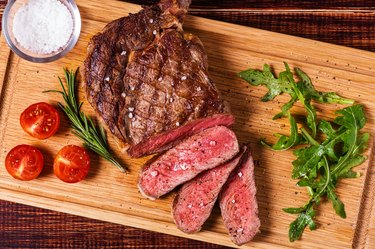
Having a body fat percentage that's higher than recommended can put you at an increased risk of heart disease and other health problems. Losing 1 percent of your body fat may mean losing just a couple of pounds if you're only slightly overweight. Improving your diet and increasing your exercise can help you lose body fat and improve your health.
Losing One Percentage of Body Fat
Video of the Day
To figure out how many pounds you need to lose to go down one percentage of body fat, you need to know your current body fat percentage. Lean body mass for most people is between 60 and 90 percent of body weight, but this varies by age and gender, with men and younger people typically having more lean body mass than women and older people. Average body fat for women is between 25 and 31 percent, and average body fat for men is between 18 and 24 percent.
Video of the Day
The American Council on Exercise gives the following formula: Desired body weight = current lean body weight/(1 - desired body fat percentage in decimal form).
First, you need to determine your current lean body mass. So, if you're a woman who weighs 140 pounds with a body fat percentage of 31, and you want to decrease this to 30, multiply 140 by 0.69 to get your lean body weight: 140 x 0.69 = 96.6 pounds.
Next, you'll determine your desired body weight. To do this, divide it by 0.7, which you got by subtracting your desired body fat percentage of 0.30 from 1. So your desired body weight equation is: 96.9 / 0.70 = 138 pounds.
So, since you currently weight 140 pounds, you need to lose 2 pounds of fat to decrease your body fat by 1 percent.
Follow a Reduced-Calorie Diet
To lose body fat, you need to lose weight, which usually means following a reduced-calorie diet. Each pound of weight loss requires you to create a caloric deficit of 3,500 calories, so to lose 1 pound per week, you need to eat 500 fewer calories each day. Don't go too low in calories, however, or you may stall your metabolism and make it harder to lose weight. Women should stay above 1,200 calories daily, and men should eat at least 1,800 calories. Stay away from fad diets; instead, eat mainly whole foods, including a mix of protein-rich foods, whole grains, fruits and vegetables.
Eat Plenty of Protein
People who don't eat enough protein during a weight-loss diet lose more muscle mass than those who eat sufficient amounts of protein, according to a study published in the Journal of the American Dietetic Association in 2008. A study published in The Journal of Nutrition in 2003 found that eating a diet with a lower ratio of carbohydrate to protein was more effective for reducing body fat and improving body composition during weight loss than a diet containing more carbohydrates and less protein.
Along with eating plenty of protein, do your best to spread it out fairly evenly between your three main meals, which helps increase muscle building compared to eating most of your protein during dinner, according to a study published in The Journal of Nutrition in 2014.
Increase Aerobic Exercise to Lose Body Fat
A study published in The Journal of Nutrition in 2005 found that dietary protein plus exercise have additive effects on improvements in body composition while people are losing weight. For weight loss, aim to get at least 300 minutes of aerobic exercise each week, if you exercise at moderate intensity, or 150 minutes of vigorous aerobic exercise. A study published in Archives of Internal Medicine in 2004 found that as people increased the amount and the intensity of their exercise efforts, their weight loss increased as well, even without dietary changes.
Include Strength Training to Build Muscle
If you don't include strength training in your weight loss routine, about one-fourth of any weight you lose will come from muscle instead of fat, increasing the amount of weight you have to lose to decrease your body fat level by 1 percent. Aim for at least two strength training sessions per week and include exercises that focus on all of the major muscle groups. Adding resistance training to a high-protein, reduced-calorie diet increases weight loss and beneficial changes in body composition, according to a study published in Diabetes Care in 2010.
- American Council on Exercise: What Are the Guidelines for Percentage of Body Fat Loss?
- Drugs.com: Exercise for Weight Loss: Calories Burned in 1 Hour
- Archives of Internal Medicine: Effects of the Amount of Exercise on Body Weight, Body Composition, and Measures of Central Obesity
- Diabetes Care: A High-Protein Diet With Resistance Exercise Training Improves Weight Loss and Body Composition in Overweight and Obese Patients With Type 2 Diabetes
- The Journal of Nutrition: Dietary Protein Distribution Positively Influences 24-h Muscle Protein Synthesis in Healthy Adults
- The Journal of Nutrition: A Reduced Ratio of Dietary Carbohydrate to Protein Improves Body Composition and Blood Lipid Profiles During Weight Loss in Adult Women
- Journal of the American Dietetic Association: Lean Mass Loss Is Associated With Low Protein Intake During Dietary-Induced Weight Loss in Postmenopausal Women
- The Journal of Nutrition: Dietary Protein and Exercise Have Additive Effects on Body Composition During Weight Loss in Adult Women
- Calculator.net: Lean Body Mass Calculator
- American College of Sports Medicine: Metabolism Is Modifiable With the Right Lifestyle Changes